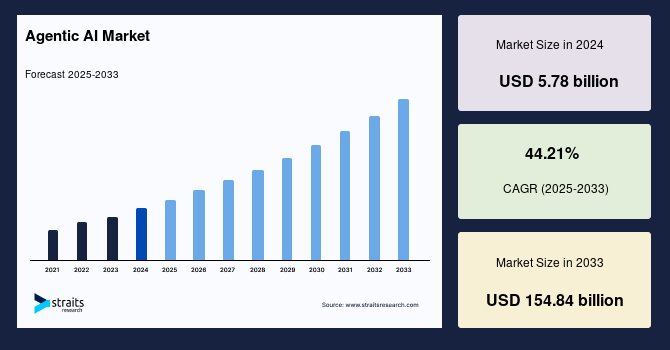AI Research
Agentic AI Market Size, Share & Growth Report by 2033

Agentic AI Market Overview
The global agentic AI market size was valued at USD 5.78 billion in 2024 and is estimated to grow from USD 8.31 billion in 2025 to reach USD 154.84 billion by 2033, growing at a CAGR of 44.21% during the forecast period (2025–2033). Rising demand for intelligent automation, enhanced decision-making, and efficiency across enterprises is driving the agentic AI market. Advanced ML, multi-agent systems, and ready-to-deploy solutions enable scalable operations, improved customer experiences, and reduced operational costs worldwide.
Key Market Trends & Insights
- North America held the largest market share, over 40% of the global market.
- By technology, the machine learning segment held the highest market share of over 30.5%.
- By agent system, the single agent systems segmentis expected to witness the fastest CAGR of 47.14%.
- By type, the ready-to-deploy agents segment is expected to witness the fastest CAGR of 42.44%.
- By application, the customer service and virtual assistants segment held the highest market share of over 30%
- By end-user, the enterprise segment held the highest market share of over 35%.
Market Size & Forecast
- 2024 Market Size: USD 78 billion
- 2033 Projected Market Size: USD 84 billion
- CAGR (2025-2033): 21%
- North America: Largest market in 2024
Agentic AI refers to artificial intelligence systems capable of acting independently to achieve goals, rather than only responding to human instructions. These AI agents can plan, make decisions, and execute tasks autonomously, often using reinforcement learning, natural language processing, and advanced algorithms. By continuously observing environments, predicting outcomes, and adapting strategies, agentic AI can solve complex problems, manage workflows, or optimize operations with minimal human intervention, effectively functioning as self-directed digital agents.
The growth of agentic AI is fueled by advancements in computational power, cloud infrastructure, and real-time data analytics, enabling faster and more efficient autonomous operations. Industries such as healthcare, logistics, and finance can leverage agentic AI to enhance precision, reduce operational costs, and improve service delivery. Moreover, integration with IoT and robotics presents opportunities for innovative applications, from smart manufacturing to personalized services, allowing organizations to automate complex tasks while gaining insights for strategic decision-making.
Latest Market Trend
Shift toward autonomous decision-making
The global agentic AI market is witnessing a clear shift toward autonomous decision-making, where AI agents are moving beyond simple task execution to making context-aware, strategic choices with minimal human intervention. This trend is fueled by advances in generative AI, reinforcement learning, and multi-agent collaboration systems.
Businesses are increasingly adopting these autonomous agents to handle dynamic operations such as supply chain optimization, financial trading, and customer engagement. The ability of agentic AI to adapt, self-learn, and respond in real time enhances efficiency and scalability. As trust and explainability improve, autonomous decision-making is becoming a defining feature of next-gen AI adoption.
Market Driver
Rising investments in AI research
Rising investments in AI research are a key driver of the global agentic AI market, enabling rapid advancements in autonomy, reasoning, and multi-agent collaboration. Major technology companies, governments, and venture capital firms are increasingly funding projects that push the boundaries of intelligent decision-making systems.
- For instance, in July 2025, Thinking Machines Lab, founded by former OpenAI CTO Mira Murati, secured a record-breaking $2 billion Series A funding round at a $10 billion valuation, underscoring investor confidence in agentic AI.
Such significant capital inflows accelerate innovation, attract top talent, and drive the commercialization of next-generation AI solutions across industries worldwide.
Market Restraint
High computational and infrastructure costs
High computational and infrastructure costs remain a major restraint in the global agentic AI market. Deploying advanced agentic AI systems requires powerful GPUs, high-performance cloud platforms, and extensive storage to process vast datasets. This leads to significant capital expenditure, making adoption difficult for small and mid-sized enterprises.
Moreover, ongoing expenses for system maintenance, energy consumption, and software updates further strain budgets. These high costs limit large-scale deployment and create disparities between tech giants and smaller players, slowing down overall market penetration.
Market Opportunity
Emerging applications in defense & space
Emerging applications in defense and space present significant opportunities for the agentic AI market, as militaries and space agencies increasingly seek autonomous solutions for complex and high-risk operations. Agentic AI enables real-time decision-making, mission planning, and multi-agent coordination in environments where human intervention is limited or unsafe.
- For instance, in May 2025, Applied Intuition introduced two defense-focused product lines—Axion and Acuity—designed to accelerate deployment of autonomous systems across air, land, sea, and space. Notably, the company also converted a GM Infantry Squad Vehicle to full autonomous operation within just 10 days, showcasing rapid adaptability.
Such advancements highlight how agentic AI is becoming central to next-generation defense strategies and space exploration initiatives.

- 📊 Preview Report Scope and Structure – Gain immediate visibility into key topics, market segments, and data frameworks covered.
- 📥 Evaluate Strategic Insights – Access selected charts, statistics, and analyst-driven commentary derived from the final report deliverables.
Regional Analysis
North America: Dominant Region
North America remains the dominant region in the agentic AI market, supported by advanced technological infrastructure, strong R&D capabilities, and robust investment in AI-driven innovation. The region leads in enterprise adoption across sectors such as finance, healthcare, and retail, where AI agents streamline operations and customer engagement. For example, major automotive firms in North America are integrating multi-agent systems for autonomous vehicle testing and deployment. With a mature digital ecosystem and significant venture funding, the region continues to set benchmarks for global agentic AI adoption.
- The United States agentic AI market is witnessing strong adoption across enterprises, driven by demand for automation, customer service enhancement, and intelligent decision-making tools. Companies are deploying ready-to-deploy agents to streamline workflows, improve productivity, and personalize customer experiences. With extensive use cases in sectors such as financial services, healthcare, and defense, the U.S. is rapidly scaling AI-driven innovations.
- Canada’s agentic AI market is expanding steadily, with enterprises embracing AI to optimize processes, improve service delivery, and enhance decision-making. Industries such as healthcare, logistics, and retail are integrating intelligent agents to manage complex operations more efficiently. Ready-to-deploy solutions are particularly popular, helping businesses achieve faster digital transformation without heavy technical resources.
Asia-Pacific: Significantly Growing Region
The Asia-Pacific region is experiencing significant growth in the agentic AI market, fueled by rapid digitalization, strong government support, and expanding enterprise adoption. Countries across the region are deploying agentic AI in applications like e-commerce, financial services, and manufacturing, driving both efficiency and innovation.
For example, leading telecom operators in Asia-Pacific have integrated virtual assistants to handle large-scale customer service demands, reducing costs while enhancing user satisfaction. With increasing investments in AI infrastructure and rising demand for intelligent automation, the region is emerging as a global growth hotspot.
- China’s agentic AI market is accelerating, supported by large-scale investments, strong government backing, and an ecosystem of leading tech companies. Enterprises are leveraging multi-agent systems and machine learning-based agents for applications in manufacturing, smart cities, and retail. The rise of AI-powered virtual assistants and robotics in consumer and enterprise sectors highlights China’s leadership in applied innovation.
- India’s agentic AI market is growing rapidly, driven by digital transformation initiatives across industries such as banking, healthcare, and e-commerce. Enterprises are adopting ready-to-deploy agents for customer service, process automation, and data-driven decision-making. The increasing demand for multilingual virtual assistants is also boosting adoption, catering to the country’s diverse user base. With strong government-led AI initiatives and expanding startup ecosystems, India is positioning itself as a key growth hub.
Market Segmentation
The global agentic AI market is bifurcated by technology, agent system, type, application, and end-user.
Technology Insights
The Machine Learning segment dominates the global agentic AI market, driving advanced predictive capabilities, decision-making, and automation across industries. Its ability to learn from data, adapt to patterns, and optimize outcomes makes it the backbone of intelligent agents. From fraud detection and recommendation engines to autonomous navigation, machine learning algorithms are powering scalable and reliable agentic solutions. With rising adoption in finance, healthcare, and enterprise automation, machine learning remains the key technology propelling innovation and shaping the competitive edge in agentic AI.
Agent System Insights
The multi-agent systems segment dominates the agentic AI landscape, offering collaborative intelligence where multiple agents interact to achieve complex objectives. This approach enables scalability, resilience, and real-time adaptability in dynamic environments. Widely applied in logistics, defense, and smart city infrastructure, these systems enhance decision-making by distributing tasks across interconnected agents. Their ability to manage interdependencies and deliver coordinated outcomes makes them essential for industries demanding efficiency and autonomy.
Type Insights
The Ready-to-Deploy Agents segment dominates the market, offering organizations pre-built, easily integrable solutions that reduce development costs and deployment time. Businesses increasingly favor these agents for applications like customer service, IT helpdesks, and process automation, where quick implementation is crucial. Their plug-and-play nature allows enterprises to scale AI adoption without heavy technical expertise, making them ideal for improving productivity and user experience. As demand for faster time-to-value rises, ready-to-deploy agents continue to capture the largest market share.
Application Insights
The Customer Service and Virtual Assistants segment represents the largest application segment, dominating due to the growing enterprise focus on enhancing customer experience. These AI-driven agents handle inquiries, resolve issues, and provide 24/7 support, reducing operational costs while improving satisfaction. From retail and banking to telecom, virtual assistants streamline interactions and personalize services, making them indispensable for businesses. With advancements in natural language processing and conversational AI, this segment is expanding rapidly in the global market.
End-User Insights
The Enterprise segment dominates the agentic AI market, as organizations adopt intelligent agents to optimize operations, decision-making, and customer engagement. Enterprises leverage these systems for automating workflows, managing resources, and enhancing productivity across multiple departments. From HR and finance to supply chain and marketing, agentic AI enables cost savings, efficiency, and data-driven insights. With the growing demand for scalability, security, and personalization, enterprises are leading adoption, positioning themselves at the forefront of leveraging agentic AI.
Company Market Share
The agentic AI market is characterized by strong competition, with leading companies focusing on diverse strategies to expand their presence. Many are investing heavily in research and development to advance machine learning, natural language processing, and multi-agent system capabilities. Others are concentrating on building ready-to-deploy agents to meet growing enterprise demand for rapid integration and scalability.
OpenAI
OpenAI, started in 2015 as an AI research organization, has evolved from open collaboration to building advanced large language models. With milestones like GPT series, it now pioneers agentic AI, focusing on autonomous systems, reasoning, and safer, scalable intelligence to transform industries while ensuring responsible innovation.
- In August 2025, OpenAI officially released GPT-5, introducing it as its most advanced and intelligent model to date. Featuring a unified system that swiftly balances quick responses with deeper reasoning, GPT-5 demonstrates expert-level performance across coding, health, writing, and multimodal tasks, significantly reducing hallucinations and boosting usability.
List of key players in Agentic AI Market
- Alibaba Group Holding Limited
- Amazon Web Services, Inc.
- Apple Inc.
- Baidu
- IBM Corporation
- Meta
- Microsoft
- NVIDIA Corporation
- Salesforce, Inc.
- Anthropic
- C3.ai
- CrewAI
- LivePerson
- Moveworks
- NICE Ltd.
- OpenAI
- Oracle
- ServiceNow

Recent Development
- February 2025 – GitHub launched Agent Mode for GitHub Copilot, significantly improving its AI-powered coding capabilities. The update enables Copilot to autonomously process high-level instructions, generate code spanning multiple files, detect errors, and apply fixes with minimal human guidance.
Agentic AI Market Segmentations
By Technology (2021-2033)
- Machine Learning
- Natural Language Processing (NLP)
- Deep Learning
- Computer Vision
- Others
By Agent System (2021-2033)
- Single Agent Systems
- Multi-Agent Systems
By Type (2021-2033)
- Ready-to-Deploy Agents
- Build-Your-Own Agents
By Application (2021-2033)
- Customer Service and Virtual Assistants
- Robotics and Automation
- Healthcare
- Financial Services
- Security and Surveillance
- Gaming and Entertainment
- Marketing and Sales
- Human Resources
- Legal and Compliance
- Others
By End-User (2021-2033)
- Consumer
- Enterprise
- Industrial
By Region (2021-2033)
-
North America
- U.S.
- Canada
-
Europe
- U.K.
- Germany
- France
- Spain
- Italy
- Russia
- Nordic
- Benelux
- Rest of Europe
-
APAC
- China
- Korea
- Japan
- India
- Australia
- Taiwan
- South East Asia
- Rest of Asia-Pacific
-
Middle East and Africa
- UAE
- Turkey
- Saudi Arabia
- South Africa
- Egypt
- Nigeria
- Rest of MEA
-
LATAM
- Brazil
- Mexico
- Argentina
- Chile
- Colombia
- Rest of LATAM
Frequently Asked Questions (FAQs)
The global agentic AI market size was valued at USD 5.78 billion in 2024 and is estimated to grow from USD 8.31 billion in 2025 to reach USD 154.84 billion by 2033, growing at a CAGR of 44.21% during the forecast period (2025–2033).
Rising investments in AI research are a key driver of the global agentic AI market, enabling rapid advancements in autonomy, reasoning, and multi-agent collaboration.
The Ready-to-Deploy Agents segment dominates the market, offering organizations pre-built, easily integrable solutions that reduce development costs and deployment time.
AI Research
From static to adaptive: Scaling AI reasoning without the waste

Most systems that employ reasoning today rely on static reasoning: every input gets the same model, the same prompt and the same depth of reasoning, leading to inefficiency and wasted time and money. A trivial query might get over-processed, driving up cost and latency. A complex, high-stakes task might be underserved, leading to risky errors.
In my view, the next frontier in production-ready reasoning is adaptive reasoning: AI systems that allocate just the right amount of reasoning per input, balancing accuracy, cost and latency in real time. For CIOs, adaptive reasoning may be a new operating model for how enterprise AI systems should be designed, deployed and scaled.
What are reasoning language models (RLMs)?
Reasoning language models are language models that can generate a thinking process. They start with a question, produce reasoning steps and arrive at an answer. RLMs can move beyond simply mapping an input to an output; they can actively engage in a multi-step decision-making process.
AI Research
University of Cincinnati launches AI Ethics Center

CINCINNATI — As artificial intelligence technology continues to evolve at a rapid pace, a group of researchers at the University of Cincinnati is launching a new initiative to ensure that ethics keep up.
Backed by nearly $500,000 in funding from the National Endowment for the Humanities and $165,000 in seed money from UC’s College of Arts and Sciences, the university has announced the formation of the Center for Explainable, Ethical, and Trustworthy AI, or CEET.
“AI looks like it’s going to be one of the most impactful and maybe revolutionary technologies of our lifetime,” said Andre Curtis-Trudel, assistant professor of philosophy at the University of Cincinnati. “That makes it one of the most exciting things to be thinking about, especially from ethical perspectives.”
The center, still in its early stages, will serve as an interdisciplinary hub bringing together faculty and researchers from a wide range of fields, including philosophy, English and physics to address how AI systems are developed, used, and understood.
“AI impacts everyone, but it’s not the case that everyone has the opportunity to contribute to conversations around AI,” Curtis-Trudel said. “In particular, about how it’s being used.”
CEET’s work is split between two main branches: a research team focused on the broader societal and ethical questions surrounding AI, and an engagement team tasked with transforming those findings into public-facing educational initiatives. That includes programming for students in the K-12 system, a key focus of the center’s outreach efforts.
“Students are increasingly going to be asked to use AI tools, and their lives will involve AI in one way or another,” said Curtis-Trudel. “It’s important that they understand how these tools work and are able to reason about them.”
Dean James Mack of UC’s College of Arts and Sciences emphasized the importance of including humanities scholars in the conversation around AI, which he says has traditionally been dominated by science and tech fields.
“This is not just a scientific or technological challenge,” Mack said. “This is a humanistic challenge that’s going to affect society, one that’s going to influence policies, not just in relation to AI but entire communities.”
Mack said the center also aims to help set ethical boundaries that prioritize public safety and social good.
“Every tool that’s in a doctor’s office can always be used to harm or to help,” Mack said. “We have to understand that the goal is to help individuals, not harm them.”
While CEET doesn’t yet have a physical space on campus, Curtis-Trudel hopes the center will position the University of Cincinnati as a national leader in humanities-driven AI research and policy.
“Our aim is to become a first port of call, a hub, for anyone interested in AI ethics,” he said.
Center staff say they are also exploring private partnerships and additional fundraising opportunities to support the initiative’s long-term goals.
AI Research
Driving Innovation in Learning and Research at Chula through AI – Chulalongkorn University

On September 5, 2025, the Social Research Institute of Chulalongkorn University organized an international public lecture titled “AI in Higher Education for Innovation in Learning & Research”, delivered by Dr. Muthu Kumar Chandrasekaran, an expert in artificial intelligence and computer technology and former Applied Science Manager at Amazon AI, at Chula Narumit House. The event was officially opened by Professor Dr. Wilert Puriwat, President of Chulalongkorn University, with Associate Professor Dr. Unruan Leknoi, Director of the Social Research Institute, delivering the welcoming remarks. A panel discussion followed, featuring Dr. Philip Soung Soo Cho, a researcher at Chula’s Social Research Institute.


President, Chulalongkorn University

Director, Social Research Institute, Chulalongkorn University

Expert in Artificial Intelligence and Computer Technology and former Applied Science Manager, Amazon AI
Objectives of the Lecture
The lecture aimed to create a platform for knowledge exchange on Artificial Intelligence (AI) between international experts and Thai academics. It also sought to provide guidance on enhancing the quality of teaching and research in Thai universities to meet global standards.
Elevating Thai Universities to the Global Stage:
The session shared best practices for applying AI to improve teaching and research. The evolution began during the MOOC era (2012–2020), with platforms such as Coursera, Canvas Network, Diversity, and Udacity.
In the pre-Generative AI era, AI applications focused on:
- Automated grading systems
- Assessing participation in online classrooms
- Scripted intelligent tutoring systems
In the current era of Generative AI and Agentic AI, developments have become more personalized, enabling the creation of personal AI tutors and positioning AI as a key tool for future learning.
Building International Networks:
The event brought about greater opportunities for collaboration between Chulalongkorn University and global academic and tech experts, reinforcing Thailand’s role in the international AI discourse.
Empowering Thai Society:
The lecture emphasized the need to equip the new generation with AI literacy, ensuring sustainable innovation. It also stressed the importance of:
- Developing inclusive AI policies
- Investing in technology and education
- Ensuring equitable access to AI tools and infrastructure
Despite AI’s potential to disrupt future labor markets and the growing concern over job displacement, it also presents new career opportunities. To adapt, reskilling and upskilling of the workforce remain essential, as people are the core driving force behind national progress. Sustainable investment in data centers was also highlighted as a key factor.
-

 Business2 weeks ago
Business2 weeks agoThe Guardian view on Trump and the Fed: independence is no substitute for accountability | Editorial
-
Tools & Platforms4 weeks ago
Building Trust in Military AI Starts with Opening the Black Box – War on the Rocks
-

 Ethics & Policy1 month ago
Ethics & Policy1 month agoSDAIA Supports Saudi Arabia’s Leadership in Shaping Global AI Ethics, Policy, and Research – وكالة الأنباء السعودية
-

 Events & Conferences4 months ago
Events & Conferences4 months agoJourney to 1000 models: Scaling Instagram’s recommendation system
-

 Jobs & Careers2 months ago
Jobs & Careers2 months agoMumbai-based Perplexity Alternative Has 60k+ Users Without Funding
-

 Education2 months ago
Education2 months agoVEX Robotics launches AI-powered classroom robotics system
-

 Podcasts & Talks2 months ago
Podcasts & Talks2 months agoHappy 4th of July! 🎆 Made with Veo 3 in Gemini
-

 Education2 months ago
Education2 months agoMacron says UK and France have duty to tackle illegal migration ‘with humanity, solidarity and firmness’ – UK politics live | Politics
-

 Funding & Business2 months ago
Funding & Business2 months agoKayak and Expedia race to build AI travel agents that turn social posts into itineraries
-

 Podcasts & Talks2 months ago
Podcasts & Talks2 months agoOpenAI 🤝 @teamganassi

